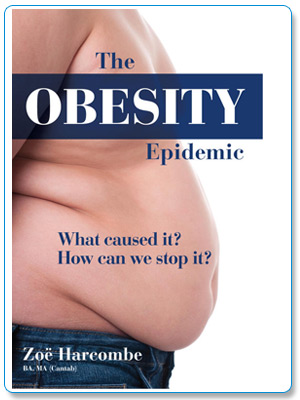References - Chapter 7
Is the calorie formula true?
90 Francis G. Benedict, Human Vitality and efficiency under prolonged restricted diet, (study 1917, published 1919).
91 James M. Strang and Frank A. Evans, “The Energy Exchange in Obesity”, Journal of Clinical Investigation, (1928).
92 Ancel Keys, The Biology of Human Starvation, (study 1944-45, report 1950).
93 Stunkard A. and M. McLaren-Hume, “The results of treatment for obesity: a review of the literature and report of a series”, Archives of Internal Medicine, (1959).
94 George A. Bray, “The Myth of Diet in the Management of Obesity”, The American Journal of Clinical Nutrition, (September 1970).
95 Search done in June 2010.
96 Rudolph L. Leibel, Michael Rosenbaum and Jules Hirsch, “Changes in energy expenditure resulting from altered body weight”, The New England Journal of Medicine”, (1995).
97 Gary Taubes’ interview of Jules Hirsch March 2002, reported in The Diet Delusion, published by Random House in the USA in 2007 as Good Calories, Bad Calories and by Vermillion, an imprint of Ebury Publishing, in the UK in 2008.
98 Julie E. Flood-Obbagya, Barbara J. Rolls, “The effect of fruit in different forms on energy intake and satiety at a meal“, Appetite, (April 2009). (Actually, it does matter if people have apple in any form before a meal – it causes insulin to be released and prepares the body to store fat).
99 Marion J. Franz, Jeffrey J. VanWormer, A. Lauren Crain, Jackie L. Boucher, Trina Histon, William Caplan, Jill Bowman, Nicolas Pronk. “Weight Loss Outcomes: A Systematic Review and Meta-Analysis of Weight Loss Clinical Trials with a Minimum 1-Year Follow-Up”, Journal of the American Dietetic Association, (2007).
100 (*) Outcome of a procedure under Article 107 of Directive 2001/83/EC; http://www.nhs.uk/news/2010/01January/Documents/Sibutramine-QA.pdf
101 James W.P.T., Astrup A., Finer N., Hilsted J., Kopelman P., Rossner S., Saris W.H.M., Van Gaal L.F., STORM study group, “Effect of sibutramine on weight maintenance after weight loss: A randomised trial”, The Lancet, (2000).
102 Weis E.C., Galuska D.A., Khan L.K., Serdula M.K., “Weight-control practices among USA adults 2001-2002”, American Journal of Preventative Medicine, (2006).
103 Sims, E. A. H., E. Danforth, E. S. Horton, G. A. Bray, J. A. Glennon, and L. B. Salans, “Endocrine and metabolic effects of experimental obesity in man”, Recent Progress in Hormone Research, (1973).
104 (*) http://www.guardian.co.uk/society/2010/jul/12/weight-watchers-works-say-scientists
105 (*) http://www.mrc-bsu.cam.ac.uk/BSUsite/CHTMR/AM_forweb.pdf
106 “The Science of Appetite”, Time Magazine, special edition, (2007).
107 (*) The WHO data was available for the discrete points 1972 and 1982 – so I took the date before the 1974 period being analysed. https://apps.who.int/infobase/indicators.aspx
108 I calculated this mathematically year on year and analysed the average calorie intake for, say, 1975 and then that for 1976 and used the 3,500 times table to work out what the average person should have gained/lost between these two years and repeated this for each year between 1975 and 1999 to calculate the overall number of pounds that should have been lost on average. The overall number was calculated cumulatively, as some years people should have gained weight and most should have produced weight loss – all according to the calorie theory.
109 (*) http://www.defra.gov.uk/evidence/statistics/foodfarm/food/familyfood/index.htm
110 (*) http://www.eatwell.gov.uk/healthydiet/seasonsandcelebrations/howweusedtoeat/changingtastes/
111 The USA has excellent data provided by NHANES (The National Health and Nutrition Examination Survey). This shows that the average weight gain, between 1974 and 1999, for a woman was 20.1 pounds and 17.6 pounds for a male. The World Health Organisation – Deakin University study (published May 2009) concurs that the average American has gained approximately 20 pounds during this time.
112 This derives from the 3,500 formula as follows: 20 (pounds) x 3,500 (calories per pound) = 70,000 ‘extra’ calories. As these have been consumed over 25 years (9,125 days, ignoring leap years), that’s 7.67 calories extra per day.
113 The FSA calories burned calculator suggested 210 calories would be burned walking for an hour, which would translate 2.3 minutes walking into eight calories. Other internet calculators are more accurate and allow you to enter an average person (160 pounds) and an average walking speed (3.5 miles per hour) and this means we would need to have walked 1.6 minutes fewer a day.
114 (*) http://www.who.int/diabetes/facts/world_figures/en/
115 Anita Chaudhuri and Jon Ungoed-Thomas, with additional reporting by Justin Stoneman, “A Dieter’s Dilemma”, The Sunday Times, (4 April 2010).
116 (*) http://www.eatwell.gov.uk/healthydiet/eatwellplate/
117 Bozenraad, Deutsche Archives Internal Medicine, (1911).

